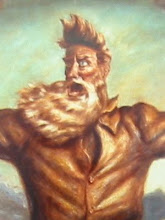"Schmoe, you need to be there at the autopsy." Words I wasn't really looking forward to hearing. I knew that I might have to attend one someday, but that might had just turned into a must.
The occasion was a fire fatality, one that had been initially thought to be foul play. You can read about the fire here.
I talked to a few of the homicide dicks, as I knew that they had been to dozens of these. Don't worry about it, they told me, I was assured that I wouldn't have to take notes or photograph the event, as the coroners office would handle all of that stuff and submit it in their report.
The autopsy was scheduled for 0900, I showed up at 0845. They made me wear a hairnet, some kind of special overalls, gloves and goggles. I assured the coroners aide that I really didn't need most of this stuff, as I wasn't going to get that close. He assured me that the primary purpose of the PPE was to prevent me from contaminating the dead people, not the other way around.
I thought about telling him: too late, I had contaminated our victim plenty. I thought better of it and went into the autopsy room.
I met the pathologist, an MD that the county contracted with to perform autopsies. He was paid $275 per autopsy and would be performing three of them at one time this morning. He had already performed two at another location on that day and would be spending the rest of his day working on reports.
The assistant was a county employee who worked with the pathologist all of the time. He was in charge of the autopsy room and ensured that it was set up, cleaned and maintained properly.
I was surprised to see three of the tables occupied, the occupants awaiting examination. My victim was going to be first, as he was a little more odoriferous than the others. The assistant began by opening up my victim, then moving on to the next. The pathologist followed behind , removing various organs, weighing some, placing all on a table next to the gurney. All the while, he was speaking into a micro-cassette tape recorder, taking verbal notes to be transcribed later.
We had pretty much decided that our victim had died accidentally, but we needed the autopsy results before making final determination. There were two primary questions that we needed answered. We needed to know if the victim was alive when the fire got to him and we needed to know if he had been disabled before the fire. In other words had someone shot or stabbed him before the fire.
The first question was easily answered. The pathologist removed the victim's trachea and cut it open. It showed a significant amount of soot in it, a sign that the patient had been breathing at the time of the fire. The second question was answered by examining x-rays that had been taken prior to the autopsy. They revealed no fractures (other than the broken bones on the lower legs caused by me walking on his incinerated feet) or no projectiles embedded in the carcass. The cherry red color of the corpse indicated that the victim had suffered significant carbon monoxide poisoning and had inhaled a lot of smoke.
The pathologist determined that the victim had died from smoke inhalation and/or thermal burns. That worked for me. As we had determined the fire was an accidental one, I could finish my report and close the file.
The pathologist offered to let me stay and observe the next autopsy, but frankly, I had seen enough. Looking at my victim laying on the table, hollowed out like a canoe and knowing that a similar fate awaited the other two corpses was reason enough for me to take my leave.
The assembly line nature of the process caught me by surprise. That the victims ended up looking like canoes was even worse. I can only assume that most of the removed material was placed back into the body and closed back up.. Regardless it will always be a canoe factory in my mind.
Thanks for reading,
Schmoe
MI Fire District Names New Fire Chief
14 hours ago


Not being an EMT but working for an ambulance service I got to take many bodies to autopsies. The first one I viewed I was definatly hesitant. After that I realized that I learned more about the human body than I ever did in any classroom, thanks to a very informative pathologist. Yes, typically everything goes back in the body and then sewn back up. This is in case further review is wanted.
ReplyDeleteAutopsy are one thing I haven't gotten used to. Dead bodies eh, as long as they're fresh. But Autopsy's IDK just something about them gives me the willies....
ReplyDeletexx
Jaxs
Anon - I figured that was what happened. I also know that some religious practices dictate that the body be interred as a whole, something that the coroners office should be sensitive to.
ReplyDeleteJackie - It was fascinating, but the entirety of the process was a little creepy for me. I forgot to mention it in the post, but they used freakin' lopping shears to crack the chest. Lopping shears! IDK.
Thanks for commenting.
Dear Captain Schmoe,
ReplyDeleteWell, it is ugh. But also interesting. I am glad you were able to keep those cookies down.
Sincerely,
Ann T.
This comment has been removed by a blog administrator.
ReplyDeleteCapt Schmoe:
ReplyDeleteSomehow, I have managed to skip autopsies. I don't find that to be a loss.
The Observer
Capt., I take it you've never watched "Dr G. Medical Examiner" on TV. It's basically a lil bit of what happened surrounding their death, autopsy, case closed.
ReplyDeleteI was suprised to see them chop through the ribcage too, though at least I don't have to smell it.